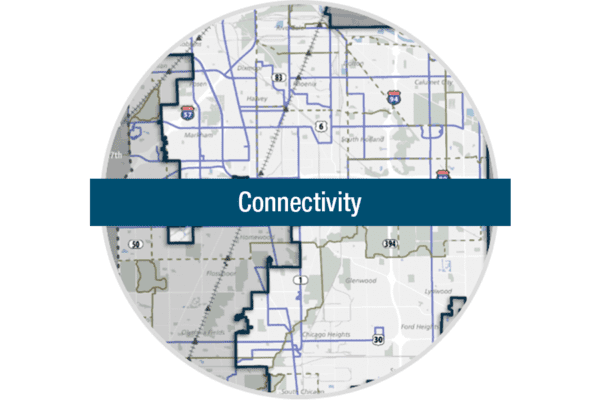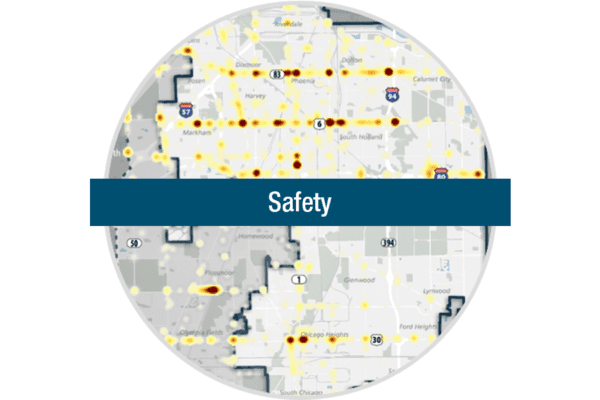
With the rapid growth of e-commerce, logistical centers are being constructed across the region. Often, they are located in rural or newly developing suburban areas that may not have the infrastructure for freight, which creates negative impacts to livability. Civiltech’s Transportation Planning team is working to help communities accommodate the economic benefits of these businesses while balancing and mitigating the negative impacts to communities. An exciting component of this work is that truck routing studies are a fairly new branch of Planning in this region born out of the increase in e-commerce.
Providing Services on Two Unique Studies
The Team has been providing services to the Chicago Metropolitan Agency for Planning for two important studies, Moving Will County and Moving South Cook County. The studies support an ON TO 2050, CMAP’s Comprehensive Plan for the region, goal of maintaining the region’s status as North American’s freight hub while balancing community concerns with the economic benefits of freight.
The team recently completed Moving Will County, a truck routing study which provides recommendations for an improved truck route network in western Will County, identifies quality of life and environmental impacts caused by heavy freight, and proposes countermeasures. The study was completed in early 2021 and approved by the Will County board in April 2022. The team is also currently working on Moving South Cook County, a south suburban Cook County truck routing and communities study, which includes a study area with freight land-use clusters, intermodal facilities, areas with large concentrations of manufacturing, warehousing, and logistics business and surrounding sensitive land uses, such as residential neighborhoods and schools.

Challenges Faced by the Communities
Logistical centers being rapidly constructed in rural, newly developing suburban areas or urban industrial areas present a number of challenges for the communities. Many challenges are infrastructure related, such as roads not designed to accommodate truck traffic or warehouses located remotely from highways resulting in navigational routes that create livability and safety issues. Routes from urban industrial areas can involve equity and livability issues, with economically disadvantaged neighborhoods impacted by truck traffic passing through. Other challenges can include environmental impacts when facility locations force freight traffic through natural resources, agricultural areas and small towns. Also, regional problems have developed as trucks need to travel between communities, passing through neighboring communities to access an expressway.

Differences and Similarities
These challenges are what differentiate the Moving Will County and Moving South Cook County studies. The heavy increase in industrial facilities is a recent development in Will County which has a large amount of farmland, prairie, unincorporated areas and newly established residential pockets. This creates many of the roadway infrastructure and environmental challenges noted above. Moving South Cook County on the other hand looks at older, established industrial areas. Therefore, the study focuses on neighborhood impacts and equity issues.
Despite the fundamental differences, the studies have overarching similarities. Both areas have been experiencing negative impacts from rapidly increasing truck traffic, are lacking adequate designated truck routes, and needed a plan to study and create or designate appropriate truck routes.
Interesting Facets of Freight Studies
The freight studies have provided meaningful project experience for Civiltech’s Transportation Planners with many interesting facets. Truck routing issues are unique for every community and offer the opportunity for innovation. The Team’s approach to Moving Will County and Moving South Cook County reflected the differences in needs between the two counties. Input from stakeholders in both communities was integral, and that input varied greatly between the two communities.
Freight studies are also unique in that near-term recommendations can often be implemented quickly and may just involve officially designating a roadway as a truck route with IDOT. For example, some roads are already designed to handle truck traffic. When those roads exist, the study can focus on the designation of routes instead of physical roadway design. These routes can be instituted quickly as truck drivers utilize GPS systems into which the newly designated routes can be entered.
Another interesting component is utilizing studies to assist communities in identifying and pursuing federal grants. With roads not yet built for truck loads, designating routes for trucks can be beneficial in acquiring funding. Planned truck routes can help communities get grants for truck route roadway construction.
A primary benefit of a freight study is removing trucks from roads that they should not be using. Designated truck routes help relocate truck traffic, accommodating the freight transport needs while protecting the community from negative impacts. In addition to a near, mid and long term truck route network, these freight studies also provide a list of needed capital investments to implement the network. For key corridors and intersections, planning level concepts and corridor profiles are also provided. These help the County and municipalities identify future projects, studies and program funding.
Understanding and Communicating with the Community
Communication with community stakeholders is perhaps the highest priority in freight studies. The public often initially assumes that conducting a freight study is actually inviting more truck traffic to the streets. Communicating the point of the study ꟷ that better accommodating trucks that already pass through the community and doing it in a way that is safer for everyone, will ensure stakeholders that the study benefits everyone.
To supplement communication efforts, understanding the community’s hot buttons is critical to this effort. Where are there truck traffic related crashes? Are there major industrial developments in the pipeline? How do community economic development decisions affect freight? Also, it is critical to understand what community and environmental resources are important to protect. This may include access to hospitals, schools, parks and recreational facilities.
Truck routing studies provide an opportunity for neighboring communities within a sub-regional area to come together in developing solutions to truck traffic, which is an issue that goes across municipal boundaries and provides a roadmap for implementation.
